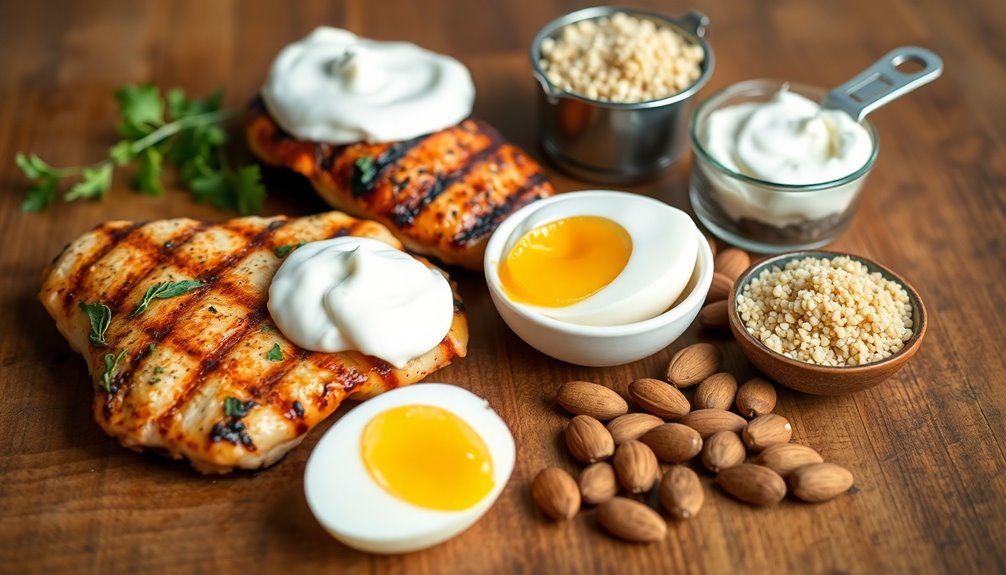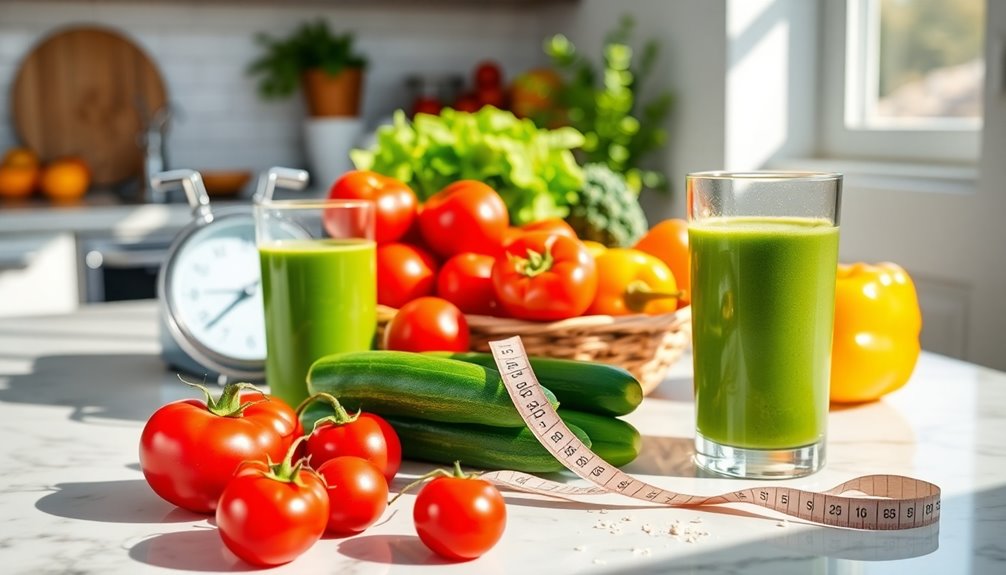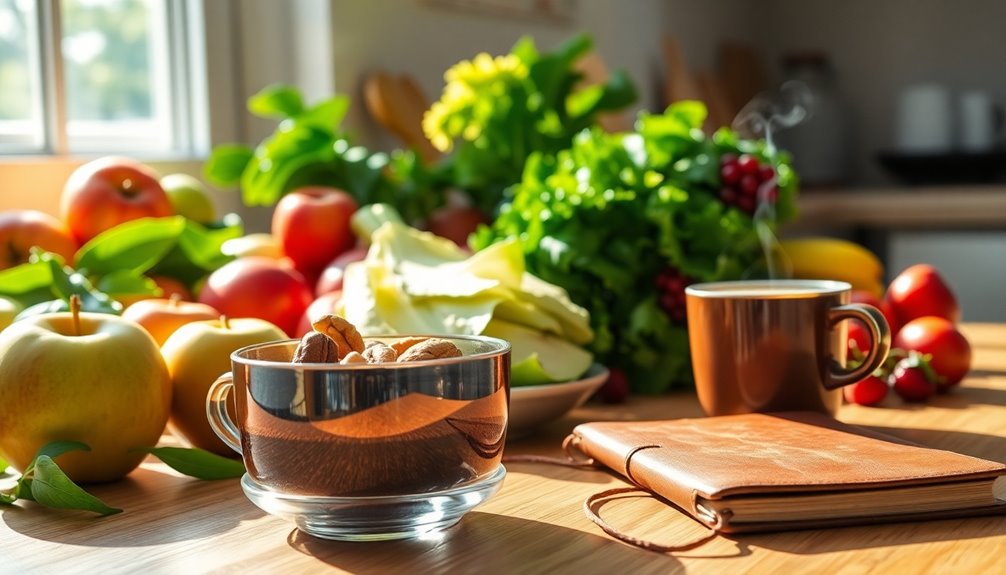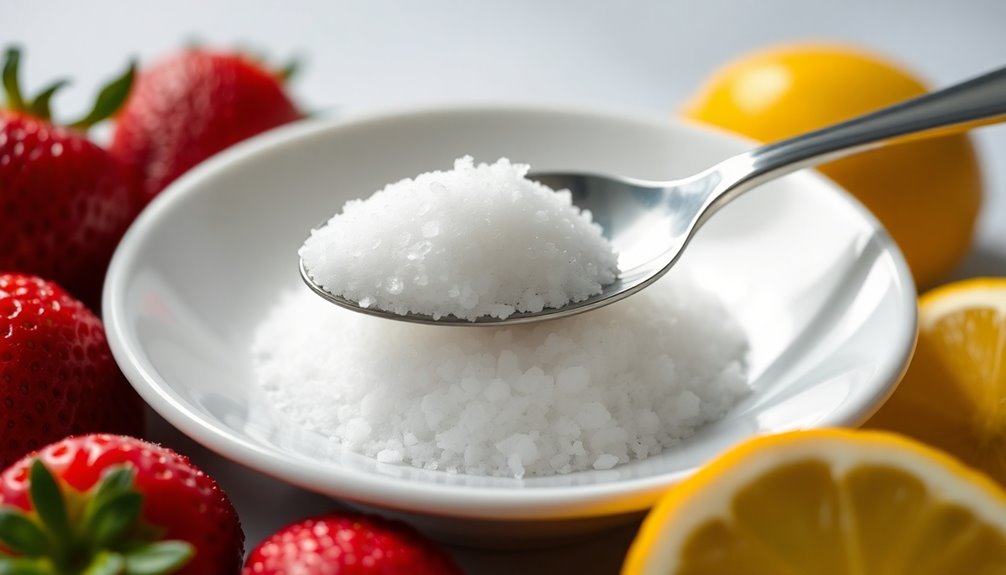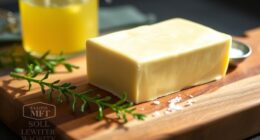Visualizing 46 grams of protein in your daily diet is easier than you think. For breakfast, have a cup of Greek yogurt with an ounce of almonds for about 26 grams. At lunch, a grilled chicken breast (about 3 ounces) adds roughly 28 grams. A couple of large eggs for a snack gives you an additional 12 grams. Finally, dinner could consist of a cup of cooked lentils, contributing around 18 grams. Combining these meals can help you exceed that 46-gram target while keeping your diet balanced and nutritious. There's more to explore about sources and meal planning that can further enhance your protein intake.
Key Takeaways
- 6 ounces of grilled chicken breast provides approximately 42 grams of protein, making it a substantial protein source for meals.
- 1 cup of cooked lentils contains about 18 grams of protein, ideal for vegetarian and vegan diets.
- 1 cup of Greek yogurt offers around 20 grams of protein, perfect for breakfast or snacks.
- Combining 2 large eggs with other protein sources can add an additional 12 grams, enhancing daily intake.
- A balanced meal plan incorporating these foods can easily meet or exceed 46 grams of protein daily.
Protein Sources for Omnivores
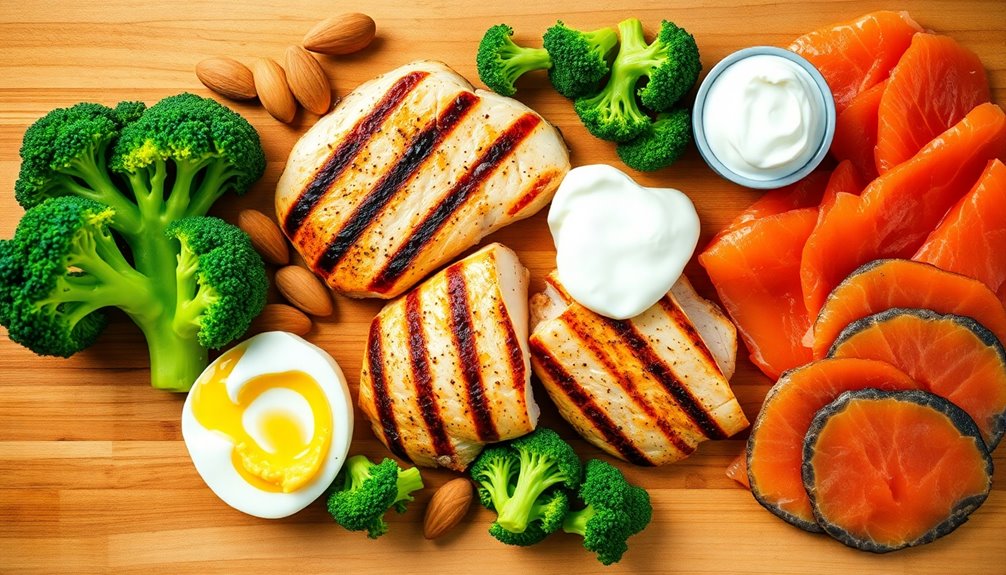
When it comes to your daily protein intake, omnivores have a wealth of options to choose from. You can enjoy a variety of animal-based sources that pack a protein punch. For instance, grilled chicken breast provides about 32 grams of protein per 100 grams, making it a fantastic option for lean protein.
If you prefer red meat, grilled beef offers around 21.7 grams, while grilled pork tops the list at 35.6 grams per 100 grams. Additionally, pork varies in fat content depending on the cuts you choose.
Seafood is another excellent choice. Grilled tuna contains approximately 34.7 grams of protein per 100 grams, and cooked salmon delivers 22.1 grams.
Don't forget about shellfish—boiled shrimp has 17.1 grams, while boiled crab provides 19.8 grams.
Dairy products can also contribute significantly to your protein intake. Greek yogurt is particularly high in protein and packed with essential nutrients.
Then there are eggs, which are a complete protein source, providing about 6-8 grams each. With options like boiled eggs and rich cheeses, you can easily meet your protein needs while enjoying diverse flavors and textures.
Protein Sources for Vegetarians
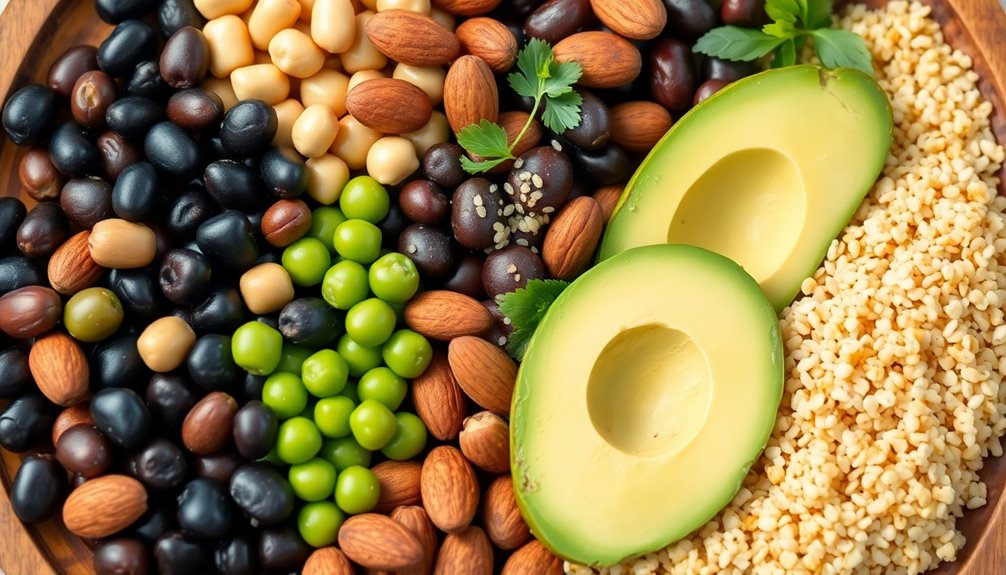
For vegetarians, a diverse array of protein sources is available that can easily meet your dietary needs.
Legumes are a powerhouse; for instance, a cooked cup of lentils packs 18 grams of protein, while black beans and chickpeas offer 15 grams each. Don't overlook kidney beans, which provide 13 grams per cup, making them excellent additions to your meals. Soybeans are also high in protein and can be enjoyed in various forms like tofu and tempeh. Incorporating healthy fats into your diet can enhance protein absorption and overall nutrition. Additionally, many legumes also contain antioxidants, which can further support your health.
Whole grains can contribute significantly too. Quinoa stands out with 8 grams of protein per cooked cup and is a complete protein, meaning it contains all essential amino acids. Oats and barley are also nutritious options, providing protein alongside fiber and vitamins. Plant-based foods are essential for vegetarians to ensure a well-rounded diet.
Vegetables, while not as protein-dense, can still help you meet your goals. For example, peas deliver 9 grams of protein per cooked cup, and broccoli adds another 4 grams.
Finally, don't forget dairy and eggs. Greek yogurt and cottage cheese are rich in protein, while a large egg provides 6-8 grams. Incorporating these foods into your diet ensures you get enough protein while enjoying a variety of flavors and nutrients.
Protein Sources for Vegans
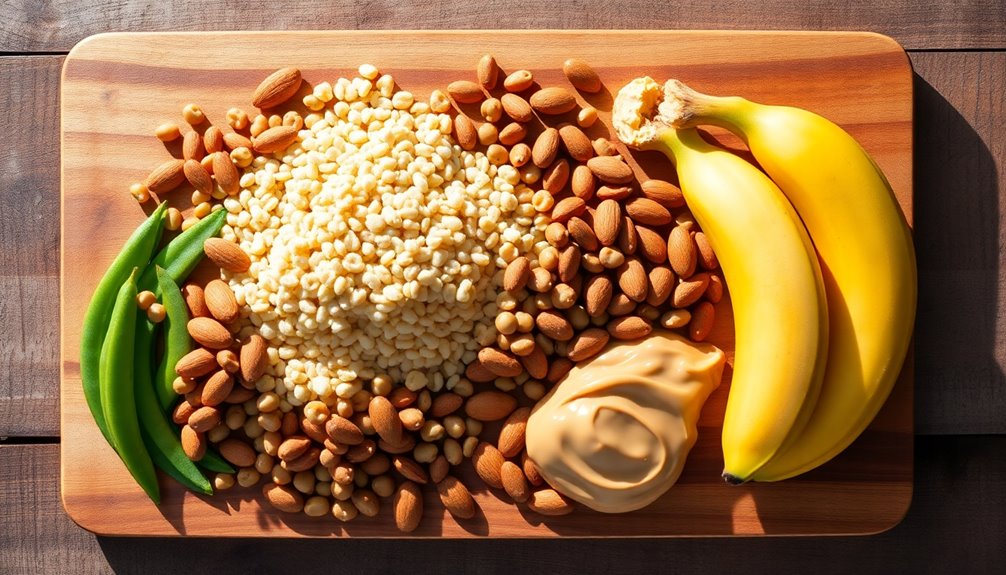
Vegans have plenty of protein-rich options to choose from, many of which overlap with vegetarian sources but exclude dairy and eggs. One of the best sources is legumes and beans, which aren't only high in protein but also packed with essential nutrients.
Lentils are a standout, providing 18 grams of protein per cooked cup. They're also rich in fiber and various vitamins. Additionally, they are an excellent source of plant-based protein, making them a staple for any vegan diet. Consuming high fiber foods like lentils can also support digestive health. Incorporating diversification in your diet by including various legumes can enhance your overall nutrient intake. Furthermore, legumes like lentils are known to promote cognitive development in early life due to their rich nutrient profile.
Black beans offer 15 grams of protein per cup and are loaded with antioxidants and minerals. If you prefer kidney beans, you'll get 13 grams of protein along with calcium and B vitamins.
Chickpeas are another excellent choice, delivering 15 grams of protein per cooked cup while being rich in iron and potassium.
Pinto beans come in slightly lower at 12 grams of protein per cup, but they're still a nutritious option with a good amount of folate and fiber.
Incorporating these legumes into your meals can easily help you meet your protein needs while providing a variety of flavors and textures. With these options, you won't feel limited in your vegan diet and will enjoy a balanced intake of nutrients.
High-Protein Animal Foods
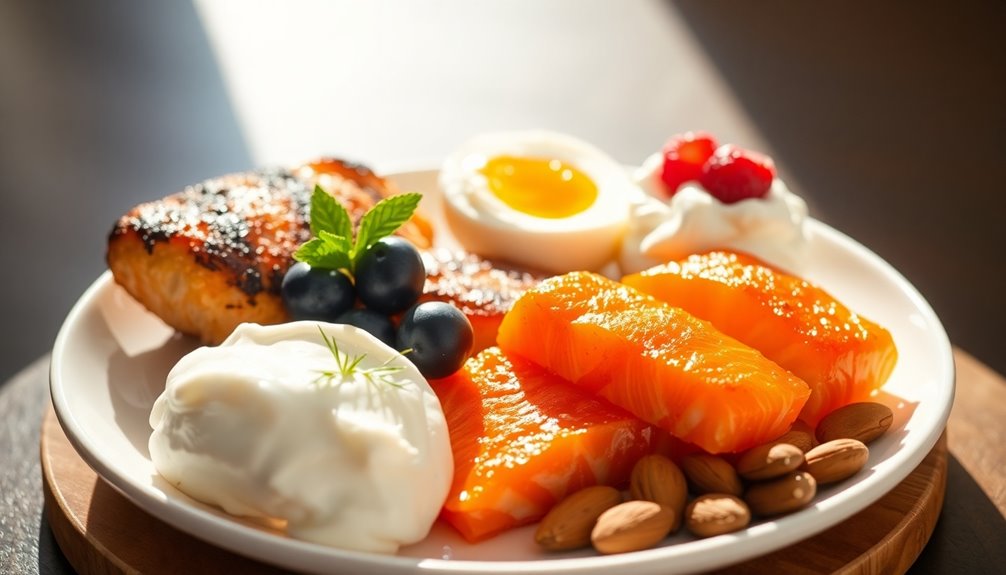
In today's world, incorporating high-protein animal foods into your diet can significantly boost your protein intake. These foods not only provide essential amino acids but also support muscle health and overall well-being. Additionally, these foods can contribute to emotional regulation, which is important for overall mental health.
When it comes to meats, grilled chicken breast stands out with an impressive 32 grams of protein per 100 grams, making it a top choice for lean protein. Grilled pork follows closely with 35.6 grams, while grilled beef offers 21.7 grams.
If you're feeling adventurous, consider grilled duck or cooked rabbit, which provide 28.7 grams and 29.2 grams, respectively.
Fish and seafood are also excellent options. Grilled tuna packs 34.7 grams of protein, and cooked salmon contributes 22.1 grams. For something different, try raw salted cod, which offers 28.8 grams.
Don't forget about dairy and eggs. A boiled egg provides 12.6 grams of protein, while cottage cheese can give you around 28 grams per cup.
Greek yogurt is another high-protein favorite, typically containing about 20 grams in a 6-ounce serving. Additionally, these animal protein sources may be linked to increased risks of heart disease when consumed in excess.
High-Protein Plant Foods
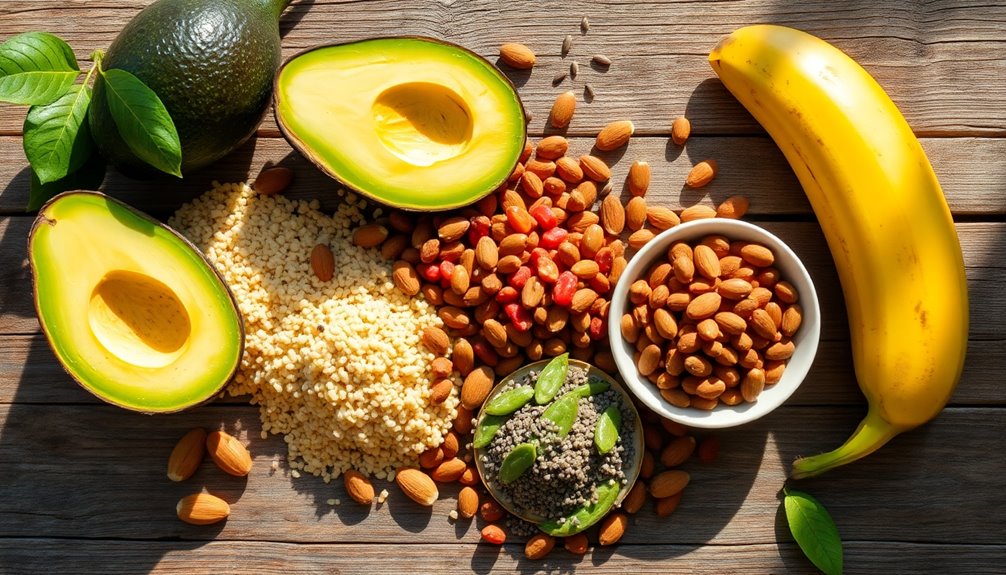
High-protein plant foods are a fantastic way to enhance your diet while reaping the benefits of essential nutrients. Incorporating legumes like lentils, chickpeas, and black beans can significantly boost your protein intake. For instance, just half a cup of lentils delivers about 8.84 grams of protein, along with fiber and iron. Additionally, cooked lentils are rich in potassium, making them a heart-healthy choice.
Nuts and seeds are another excellent source. A half-cup of almonds provides a whopping 16.5 grams of protein, while peanuts offer 20.5 grams. You can easily add pumpkin seeds or chia seeds, which are high in omega-3 fatty acids, to your meals for extra nutrition. Chia seeds also contribute essential amino acids, making them a valuable addition to a vegan diet. Incorporating chia seed pudding into your breakfast routine can also be a delicious and nutritious way to increase your protein intake.
Don't forget about soy products. Tofu and tempeh are versatile options, with tempeh packing up to 20 grams of protein per half cup. Edamame is also a delicious choice, giving you 8.5 grams per half cup.
Lastly, consider grains like quinoa and oats. Quinoa stands out with 8 grams of protein per cup, and oats provide 4.4 grams per serving.
Frequently Asked Questions
How Can I Track My Daily Protein Intake Effectively?
To track your daily protein intake effectively, start by checking nutrition labels on packaged foods for serving sizes and protein content.
Use apps like Protein Pal to set goals and easily log your meals. You can also search food databases for fresh produce.
Weigh your cooked proteins and estimate portions, spacing out your intake throughout the day.
Consistent tracking and adjusting based on your activity level will help you meet your protein needs seamlessly.
What Are the Benefits of Consuming Protein After Workouts?
Consuming protein after workouts helps you repair and rebuild muscle damaged during exercise.
It provides the essential amino acids your body needs for muscle protein synthesis, which is crucial for growth and recovery.
The best time to consume protein is within 30 minutes post-workout to maximize muscle repair.
Can I Meet My Protein Needs With a Plant-Based Diet?
Yes, you can absolutely meet your protein needs with a plant-based diet!
Focus on incorporating a variety of sources like beans, legumes, nuts, seeds, and whole grains into your meals. By tracking your intake and ensuring you spread protein across the day, you'll get enough essential amino acids.
Don't forget about soy products and consider protein supplements if needed.
With careful planning, you'll thrive on a plant-based diet while meeting your protein goals.
How Do Cooking Methods Affect Protein Content in Foods?
Cooking methods significantly affect protein content in foods. When you boil or steam, you preserve protein quality and improve digestibility, while grilling or broiling can lead to nutrient loss due to high heat.
Baking at moderate temperatures helps maintain protein structure, but overcooking can reduce bioavailability.
To optimize nutrient retention, use gentle techniques like poaching, and consider marinating proteins to minimize harmful compounds and enhance flavor without sacrificing health.
Are There Protein Supplements That Complement a Balanced Diet?
Yes, there are protein supplements that can complement a balanced diet.
You can choose from whey, plant-based, or collagen proteins, depending on your dietary preferences. These supplements help fill gaps in your protein intake, especially when you're busy.
However, they shouldn't replace whole foods; think of them as an addition to your meals or snacks. Aim for a variety of sources to ensure you're getting all essential amino acids for optimal health.
Conclusion
Incorporating 46 grams of protein into your daily diet is easier than you might think! Whether you're an omnivore, vegetarian, or vegan, plenty of delicious options are available to help you meet your protein needs. By focusing on high-protein animal and plant foods, you can create balanced meals that fuel your body. So get creative in the kitchen, experiment with different sources, and enjoy the benefits of a protein-rich diet for your overall health!
